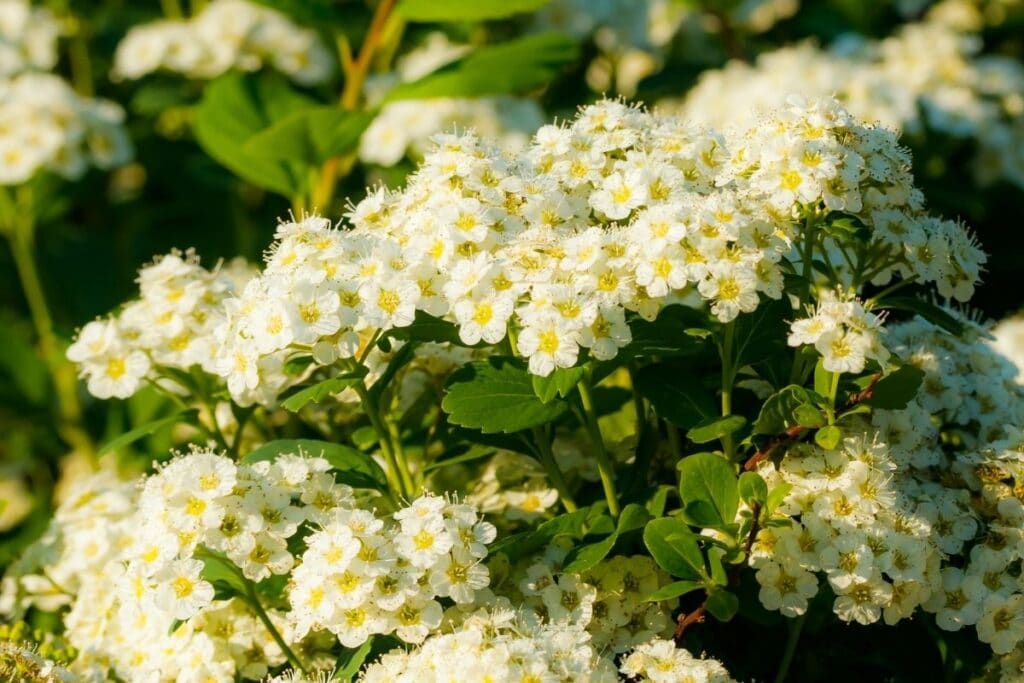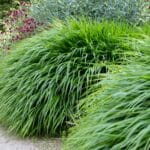Spirea plants are flowering shrubs that come in several different varieties and can make a wonderful addition to any garden or landscaping. Spirea plants are known for their vibrantly colorful flowers, attractive foliage, and for their versatility. Many plant their spirea plants as shrubs around their property, as a ground cover, and even in containers.
One of the most notable features of the spirea plants is the plant’s long bloom season. While you’re still waiting on your other flowering bushes to bloom, and when your other flowering bushes have already stopped blooming, your spirea blooms will still be going strong, especially if you plant multiple different varieties. With so many different varieties and colors of spirea plants to choose from, there’s one for everyone.
What Are Spirea Plants?
Spirea plants (commonly known as spiraea, steeplebushes or meadowsweets) are deciduous perennials, meaning that they lose their foliage in the winter months, but come back up in the spring once temperatures start to rise again. The spiraea is known for their heartiness.
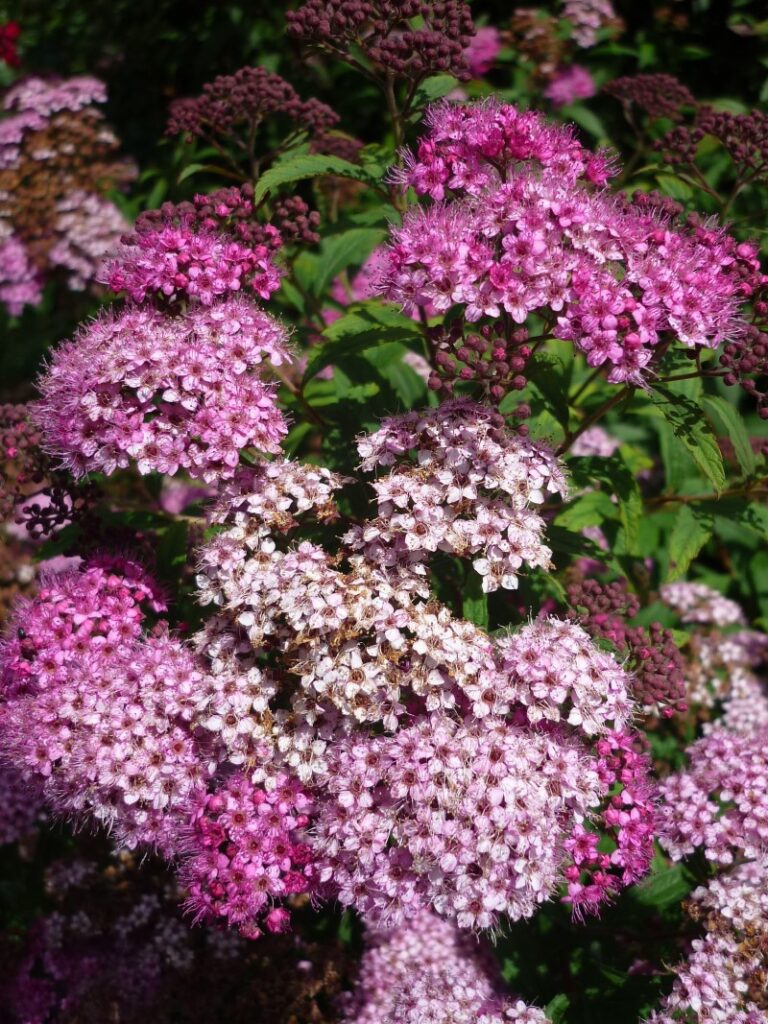
These plants can be kept in USDA hardiness zones 3 through 8, which incorporates much of the contiguous United States. The spiraea is said to be one of the hardiest flowering plants within these hardiness zones.
There are more than 80 different species of spirea bushes available, but they all have similar qualities. Spirea plants are flowering plants, and many are grown as a bush or a shrub. Some varieties may also work as a ground cover, while others grow tall enough to be trimmed as a hedge.
Whatever your need may be for the spirea, you will enjoy beautiful flowers throughout the growing season. Flowering spirea plants generally have either white, pink, or purple red flowers, although there are many different shades available in between.
The pink flowers are small, but form in large clusters that resemble one large flower head. Flowers grow in large groups on bare branches before the leaves come out in early spring.
There are two main variations of the spirea bush, spring-blooming and summer-blooming. In general, the spring bloomers have white flowers, while the summer-blooming varieties have pink to red flowers, such as Spiraea japonica (Japanese meadowsweet or Japanese spirea); there are a few exceptions to this rule.
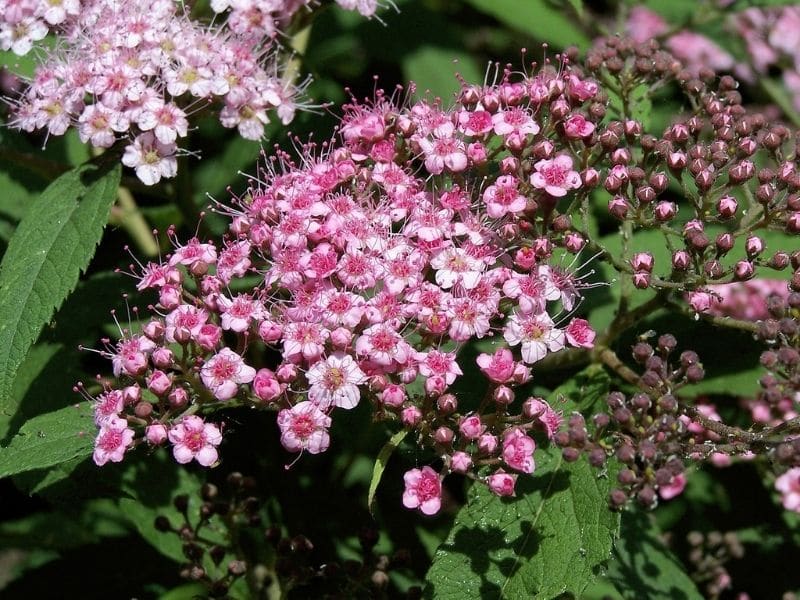
The spring-blooming varieties will flower between April and May while the summer-blooming varieties bloom from June to August. To get the most flowers in your garden, consider planting both spring- and summer-blooms to keep deep pink flowers around longer.
Common Types of Spirea Plants You Can Grow
With more than 80 different spirea varieties, you have a wide array of options to choose from. Spring-blooming vs. summer-blooming is one of the main differences when it comes to varieties of spirea plants, but there are other differences as well. Some spirea bushes grow tall, while others form as a small shrub, some even spread out like a ground cover.
Bridal Wreath Spirea

The bridal wreath spirea is one of the largest growing varieties, with some reaching heights of up to eight feet and widths of six to eight feet. Although spirea isn’t classified as a hedge, this variety grows large enough to be used as a hedge-like plant for privacy needs.
This variety of spirea is spring-blooming, meaning it will bloom between April and May. The bridal wreath spirea has pure white flowers that form in a cascading manner on a mature spirea bush.
Triumphans Spirea
The triumphans spirea is one of the most popular varieties available. This variety is generally grown as a shrub, and is often planted along with other spirea plants in flowering perennial gardens. The triumphans can grow to be between four and six feet tall, and often require some pruning to keep their shape uniform.
The triumphans are a summer-blooming variety of spirea, blooming between June and August. The flowers on the triumphans spirea are a vibrant pink color that will catch the eye of anyone passing by.
Magic Carpet Spirea
Magic carpet spirea is a variety of spirea that can be grown as a ground cover if you hadn’t already guessed that by the name. Although the plant can grow to be two feet tall, it more commonly stays below a foot and spreads horizontally instead of vertically as it grows.
This variety can also be grown well in a container or in locations where not much garden room is available, making it a popular choice for those with small yards.
The magic carpet spirea is considered a summer-blooming variety, but generally starts to bloom in late spring before most other summer-blooming varieties would have. The flowers are bright pink that form in clusters, creating the appearance of large flowers.
Double Play Red Spirea
Although most spireas are a range of pink and white shades, there is a variety that has true red blooming flowers. Another aspect that makes the double play unique is that it is a spring-blooming plant.
A majority of spring-blooming spirea have white flowers, but this variety blooms a deep red. This is a perfect addition to your garden of other spirea bushes because it will add a nice pop of color.
The double play red spiraea grows between two and three feet tall and two to three feet wide. If pruned often, it can be trimmed into a beautifully uniform shrub.
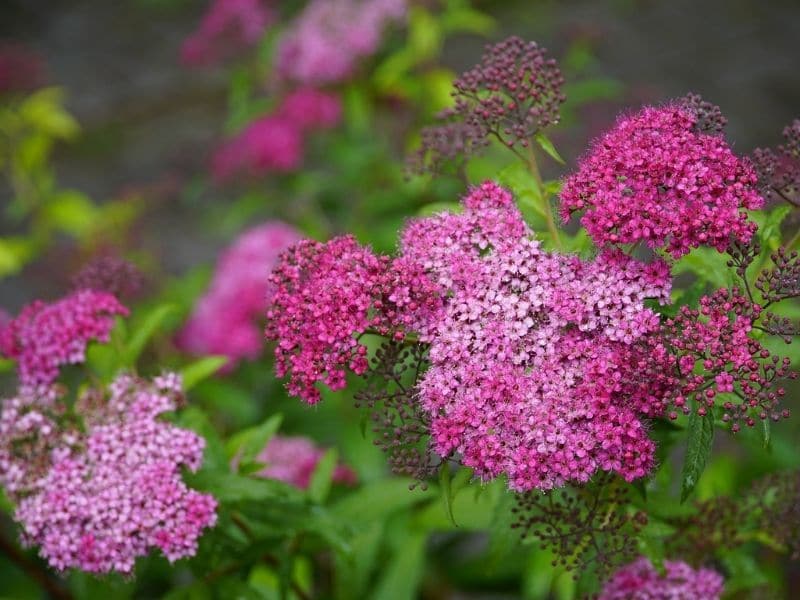
How to Care for Spirea Bushes
Overall, spirea plants are very easy to care for. These plants are very hardy, and won’t require much attention throughout the growing season.
Many restaurants and stores opt to grow different spiraea bushes as landscaping primarily due to their low-maintenance aspect. This is another reason why many gardeners like to plant spirea plants; they are an easy way to add color to your landscaping without much hassle.
Although they are easy to care for, there are ideal situations that will keep them happy and healthy.
Sun Exposure
Spirea plants grow best in full-sun locations, meaning they prefer at least six hours of direct sunlight every day. Spiraea bushes that are grown in full sun are more likely to reach their highest potential growth and will generally bloom more flowers than a plant grown in partial shade. The colorful foliage of the spirea will also turn pretty yellows and reds if kept in full sun, adding to the appeal.
Some claim that partial shade is also an option for spirea bushes, which may be true, especially in the warmer climates. Although you may be able to plant spirea in partial shade, it may not grow as well as it would in full sun.
Soil
Spirea plants do best in well-drained soil, as they don’t like to have their roots soaking in water. Roots that are left in too much water can develop root rot, which can be harmful to the plant’s health. Consistently moist soil is best for the spiraea plant, but it can withstand some small periods of being dry with little to no harm done to the plant.
Spirea plants will generally do well in nearly any soil conditions. Soil with an average nutrient
content is the most common, and your spirea plant will do well in this environment.
Although not necessary, these plants do prefer slightly acidic soil between 6 and 7pH. Spiraea bushes planted in slightly acidic soil are said to have more vibrantly colored flowers once they bloom.
Watering
If you don’t have much time to spend watering your flowers, the spirea may be a good choice for your landscaping. Generally, spiraea can get the water they need from rainfall unless you are having a particularly dry season.
If you do need to water your spiraea, you should only need to do so once a week in the hottest parts of the season. Keeping the soil evenly moist is ideal for these plants, but not necessary at all times for them to thrive.
After you’ve first planted your spirea, make sure to water them well those first few weeks as they adapt to their new environment. Young plants will benefit most from weekly watering, which you can start to cut back on once the plant becomes more established.
Fertilizing
Fertilizing is another optional aspect of growing spirea plants. Some choose to fertilize their spirea plants lightly once a year, which can help to keep the plant healthy and blooming as many flowers as possible. A spirea bush that is not fertilized yearly can still thrive, but should be watched for signs of decline. Adding fertilizer later down the line is always an option if you feel it becomes necessary.
There are two times in a spirea plant’s life where fertilizing may be important. Right after you plant your spirea, a light fertilizer can help the plant adapt to your soil better if it had received fertilizer previously. Fertilizing lightly during the first growing season can also help to give your spirea plant a good start as it becomes established and blooms for the first time.
Pruning
Pruning is not always necessary with spirea plants, but for those growing them as a shrub or small hedge, it may be of importance. Many spiraea plants will grow in a uniform shape. To keep their shape uniform and clean looking, pruning any stray growth is good to do once a season.
You may also need to prune your spirea plants if you are keeping them as a ground cover. Ground cover spreads horizontally, and is more likely to invade the space of neighboring plants than a variety that grows vertically.
If you do prune your spiraea plant, pay attention to whether it is a spring-blooming or a summer-blooming variety. Spring-blooming varieties should be pruned right after flowering, as they bloom on old growth. Summer-blooming varieties should be pruned closer to winter, after the blooms have come and gone, this is because summer-blooming varieties bloom on new growth each year.
Regardless of when you do your pruning, trimming lightly is always recommended. If a spirea plant is trimmed too aggressively, it can lead to damage on the over-pruned sections.
Sometimes a plant that is pruned too heavily will not continue to grow well or bloom the following season. If you do need to take off a decent amount of branches, do so when the plant is dormant for the season, this is less likely to lead to damage to the plant.
Propagate Spiraea
Propagation of Spiraea can be accomplished through several methods, including stem cuttings, division, and layering.
Stem cuttings are taken from healthy, mature plants during the active growing season. Pick a stem that isn’t blooming and cut it cleanly just below a leaf tip.
Remove any lower leaves and dip the cut end in rooting hormone before planting it in a well-draining potting mix. Keep the cutting consistently moist and provide warmth and indirect sunlight to encourage root development.
Division involves separating the plant’s root mass into smaller sections, each with their own shoots and roots. Layering, on the other hand, helps roots grow on stems that are still connected to the parent plant.
Spirea Plant Foliage
When choosing a flowering plant or bush for a garden or for landscaping, many don’t take foliage into account. Many perennials have standard foliage of green leaves that turn brown and die in the cooler months spirea plants are a different story. Many varieties of spiraea bush have beautiful fall leaves that keep your garden looking alive after blooms have fallen off and died.
Certain varieties of spirea shrubs boast bright yellow, orange, or red leaves in middle to late fall. Some varieties will have a combination of these colors as the seasons get cooler, creating a beautiful cascade of fall colors.
Some varieties of spirea also have beautiful foliage in the early summer months as well. The magic carpet and double play varieties mentioned previously are a couple of the varieties that will start with burgundy-tinted leaves which slowly transform into a green color as the season progresses. Other varieties have gold colored leaves throughout the summer months.
Pests and Diseases That Can Harm Your Spiraea
Although spirea plants are not prone to pests, there are a few to watch out for. Treating for pests and taking care of them early are the best ways to keep your plants from becoming damaged due to infestations.
Aphids
Aphids are fairly common pests to be on the lookout for in any type of garden. Aphids will attach themselves to the underside of leaves and will suck the nutrients from the plant. An aphid infestation can result in yellowing and dying leaves in spirea plants but does not often kill them.
Aphids can sometimes be eliminated by spraying water on the underside of leaves that are infested, essentially knocking the aphids right off the plant. There are also insecticide sprays that will do the trick if your plants are being damaged by aphids.
Spider Mites
Spider mites are another common pest that can affect your spirea shrub. Again, the spirea bush is fairly resilient, so it will most likely take only minimal damage from an infestation. It is still a good idea to handle any noticeable infestations before they get out of hand. Spider mite infestation on a spirea shrub may look like yellowing spots forming on the leaves of the plant, and webbing may also occur.
Once noticed, spider mites can be treated easily by watering the plant to keep it healthy enough to fight the infestation. Spider mites often show up when a plant is not receiving enough water to begin with, so watering the plant can help greatly. Spraying neem oil or a light insecticide is another option for getting rid of a more intense spider mite infestation.
Powdery Mildew
Powdery mildew is a fairly common fungal infection that affects many garden plants. This fungus occurs most often in moist and dark conditions, so a spirea that is planted in full sun is not likely to get powdery mildew. Powdery mildew is easily recognizable by white powdery growth that occurs on leaves, flowers, and stems.
Keeping a light fungicide spray available for your spirea plants is a good way to both prevent and treat powdery mildew. If caught early enough, powdery mildew will not damage your spirea plant.
How Long Does it Take Spirea to Grow?
There are many types of shrubs and bushes you can grow. Spirea is known for being fast growers, and are a great choice if you are wanting a mature-looking garden quickly. If you take good care of your plants and provide them with proper care, you can expect established and mature plants within a couple of years.
Spirea bush is also said to grow better and faster when planted with other spirea bushes. It is recommended to plant them in groups of at least three from a landscaping point of view. No matter how you choose to grow them, though, you’re sure to fall in love with their gorgeous foliage!
FAQs
Where does spirea grow best?
Spirea grows best in locations with well-draining soil and full sun to partial shade. It thrives in various climates but generally prefers temperate regions with moderate rainfall.
When should spirea be cut back?
Spirea should be cut back in late winter to early spring before new growth begins. This timing allows for rejuvenation pruning and promotes vigorous growth and abundant flowering during the growing season.
What is the lifespan of a spirea?
The lifespan of a spirea can vary depending on the species and growing conditions. Generally, spireas are long-lived shrubs that can persist for 10 to 20 years or more with proper care and maintenance.
Why do my spireas keep dying?
Several factors can contribute to spireas dying, including overwatering, underwatering, poor soil drainage, nutrient deficiencies, pests, diseases, or environmental stressors. Assess the plant’s growing conditions and address any issues promptly to improve its health and longevity.
Do spireas like sun or shade?
Spireas prefer full sun to partial shade. While they can tolerate some shade, they typically produce more abundant blooms and healthier foliage when grown in full sun. Ensure they receive at least 4-6 hours of direct sunlight per day for optimal growth and flowering.
Is spirea deer resistant?
Yes, Spirea is generally considered deer-resistant, but not entirely deer-proof.
Final thoughts
Finally, it’s important to take good care of spirea bushes so they stay healthy and look great in the yard. Gardeners can make sure plants grow and flower well by giving them enough sunshine, dirt that drains well, and regular washing.
When you prune at the right times, you support thick growth and lots of flowers. Spirea bushes will also stay healthy for years to come if you keep an eye out for pests and diseases and take care of any problems right away.
Gardeners can enjoy the beauty and flexibility of spirea bushes in their yards by taking these steps to take care of them.
*Featured image by depositphotos.com/ElenaNoeva

